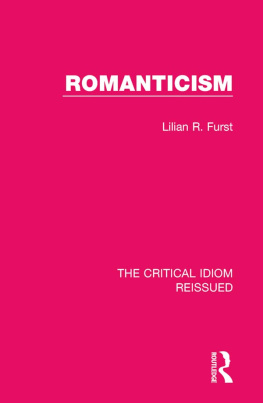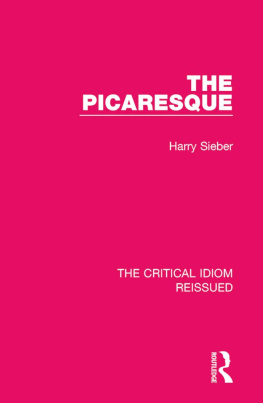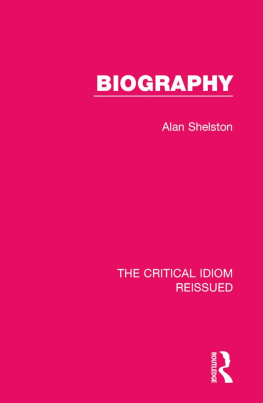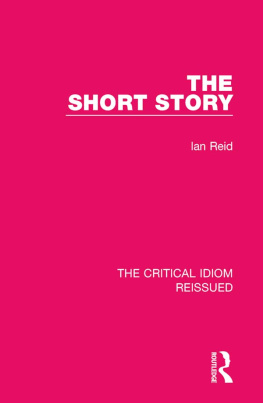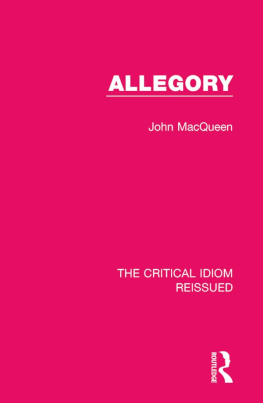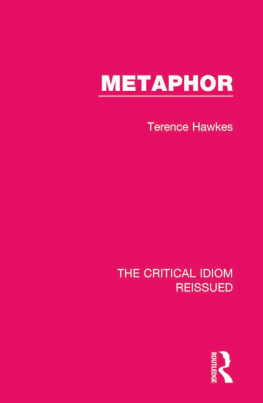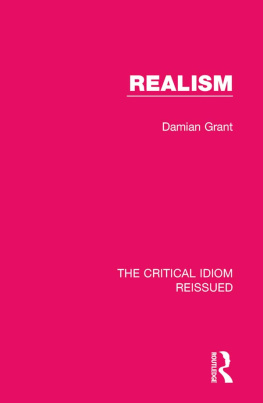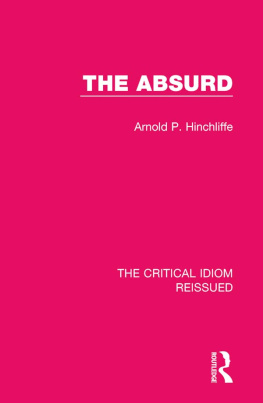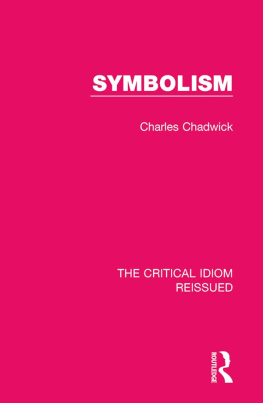Table of Contents
Guide
Print Page Numbers
THE CRITICAL IDIOM REISSUED
Volume 2
ROMANTICISM
ROMANTICISM
LILIAN R. FURST
First published in 1969 by Methuen & Co Ltd
Reprinted in 1971, 1973
Second edition published in 1976
This edition first published in 2018
by Routledge
2 Park Square, Milton Park, Abingdon, Oxon OX14 4RN
and by Routledge
711 Third Avenue, New York, NY 10017
Routledge is an imprint of the Taylor & Francis Group, an informa business
1969 and 1976 Lilian R. Furst
All rights reserved. No part of this book may be reprinted or reproduced or utilised in any form or by any electronic, mechanical, or other means, now known or hereafter invented, including photocopying and recording, or in any information storage or retrieval system, without permission in writing from the publishers.
Trademark notice: Product or corporate names may be trademarks or registered trademarks, and are used only for identification and explanation without intent to infringe.
British Library Cataloguing in Publication Data
A catalogue record for this book is available from the British Library
ISBN: 978-1-138-21971-7 (Set)
ISBN: 978-1-315-26975-7 (Set) (ebk)
ISBN: 978-1-138-24176-3 (Volume 2) (hbk)
ISBN: 978-1-315-11564-1 (Volume 2) (ebk)
Publishers Note
The publisher has gone to great lengths to ensure the quality of this reprint but points out that some imperfections in the original copies may be apparent.
Disclaimer
The publisher has made every effort to trace copyright holders and would welcome correspondence from those they have been unable to trace.
Romanticism
Lilian R. Furst
First published 1969
by Methuen & Co Ltd
11 New Fetter Lane London EC4
Reprinted 1971, 1973
Second edition 1976
1969 and 1976 Lilian R. Furst
Filmset by Computer Photoset Ltd.
and printed in Great Britain by
Cambridge University Press
ISBN 0 416 83910 X (Hardback)
ISBN 0 416 83920 7 (Paperback)
This title is available in both hardback and paperback editions. The paperback edition is sold subject to the condition that it shall not, by way of trade or otherwise, be lent, resold, hired out, or otherwise circulated without the publishers prior consent in any form of binding or cover other than that in which it is published and without a condition including this condition being imposed on the subsequent purchaser.
Distribution in the USA
HARPER & ROW PUBLISHERS INC
BARNES & NOBLE IMPORT DIVISION
Contents
The volumes composing the Critical Idiom deal with a wide variety of key terms in our critical vocabulary. The purpose of the series differs from that served by the standard glossaries of literary terms. Many terms are adequately defined for the needs of students by the brief entries in these glossaries, and such terms do not call for attention in the present series. But there are other terms which cannot be made familiar by means of compact definitions. Students need to grow accustomed to them through simple and straightforward but reasonably full discussions. The purpose of this series is to provide such discussions.
Many critics have borrowed methods and criteria from currently influential bodies of knowledge or belief that have developed without particular reference to literature. In our own century, some of them have drawn on art-history, psychology, or sociology. Others, strong in a comprehensive faith, have looked at literature from a Marxist or a Christian or some other sharply defined point of view. The result has been the importation into literary criticism of terms from the vocabularies of these sciences and creeds. Discussions of such bodies of knowledge and belief in their bearing upon literature and literary criticism form a natural extension of the initial aim of the Critical Idiom.
Because of their diversity of subject-matter, the studies in the series vary considerably in structure. But all the authors have tried to give as full illustrative quotation as possible, to make reference whenever appropriate to more than one literature, and to write in such a way as to guide readers towards the short bibliographies in which they have made suggestions for further reading.
John D. Jump
University of Manchester
I should like to express my thanks to Professor J. D. Jump for his sound and ready advice at every stage as well as for the helpful suggestions of his editorial pencil. I am also most grateful to four research students, Miss J. Aldridge, Miss B. Blades, Mrs M. Gluckman and Miss C. Robinson for their meticulous scrutiny of the typescript and for their constructive criticisms.
In preparing the second revised edition I must acknowledge the help of many students who have used the first edition, have asked questions and made comments which have revealed to me new aspects of Romanticism as well as gaps in my text. I am specially indebted to my colleague Dr Robert M. Jackson, and to Antonio Gil, William Sims, Janet Sutherland and Dr Ester Zago, graduate students at the University of Oregon, for helpful suggestions and bibliographical information. And last but by no means least to Pat Krier for coping with my scribbles with such understanding and goodwill.
He who seeks to define Romanticism is entering a hazardous occupation which has claimed many victims. This timely warning was issued by E. B. Burgum in an article on Romanticism in the Kenyon Review of 1941, but it has not deterred critics in their ceaseless endeavours to arrive at some definition of this term. The definitions are, therefore, legion, numbering almost as many as those who have written on this subject. The difficulty in approaching Romanticism is thus less that of of finding a definition, than of finding ones way through the maze of definitions that have already been put forward. The aim of this monograph is not to add one more to the list of definitions under the illusion that it may be

